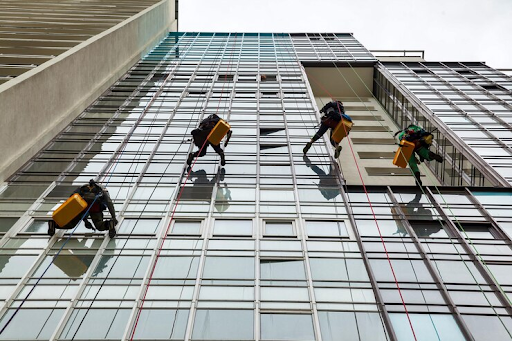The process of cleaning a particularly large commercial building implies top-level planning, cooperation, and effective tactics to cover all necessary cleaning stages. Entryways, stairwells, corridors, and even restrooms, offices, and reception areas should be kept clean to give a good first impression as well as help curb the spread of diseases. This article discusses measures and recommendations on how to clean multi-story commercial buildings to maintain hygiene.
1. Develop a Comprehensive Cleaning Plan
General cleaning of buildings entails preparing a cleaning schedule and that is why it is essential to prepare one for this type of commercial building. Tour the building and separate it into zones, like lobby cleaning, Professional high rise window cleaning, floor cleaning, etc. And then estimate the clean frequency for each zone depending on the traffic. Defines general duties and specifies who should undertake which duty to cover all areas of the building.
2. Utilize Proper Cleaning Equipment and Supplies
Using superior quality cleaning equipment and supplies is paramount in the process of attaining a quality output. Make sure the cleaning staff are provided with vacuum cleaners, mops, floor scrubbers, and other relevant tools used especially in tall buildings. The use of organic cleaning products which are efficient but not hazardous to the earth and those who occupy the building.
3. Implement Regular Floor Care and Maintenance
It is usually the floor of a commercial building where people tread most heavily and, thereby become discolored and worn out through frequent use. Follow a vacuuming schedule or specific floor treatment that involves sweeping, mopping, and polishing to avoid damage to the flooring and to keep the place clean. Areas that have carpet get carpet cleaning services to avoid the buildup of dirt and dust. Stair and floor care should also be taken professionally at some intervals to do the thorough cleaning and treatment of the floors.
4. Focus on High-Touch Areas and Restrooms
Treads, handrails, door knobs, elevator buttons, and fixtures that are routinely touched within restrooms also need special attention and thorough washing at least once a day. Products that are recommended for use by the anti-bacterial and anti-viral control board should be used in the control of bacteria and viruses that are present. Bathrooms should be washed frequently daily, and cleanliness should be focused on the toilet, faucet, mirror, and floor.
5. Ensure Proper Waste Management and Recycling
Sustainable sanitation is critical to hygiene and curtailing bad smells in commercial structures. The waste disposal must be done properly, there must be sufficient waste bins and these bins should be cleared frequently. The next step to enhance sustainable practices among the building occupants is to introduce a recycling program aimed at increasing their recycling habits of the use of paper, plastics, and other waste materials.
Conclusion
Cleaning commercial buildings, especially multi-storey is partly a technical task that has to be accomplished in proper sequential order and with a special focus on certain aspects of cleanliness. By creating a cleaning strategy, choosing the right equipment and products, cleaning the floor regularly, suggesting concentrating on the often-touched spots and lavatories, and using receptacles, you can keep the working place and avoid infections for the employees and guests.

